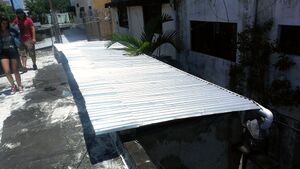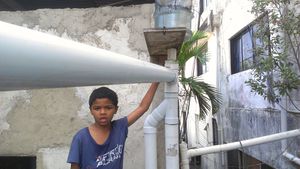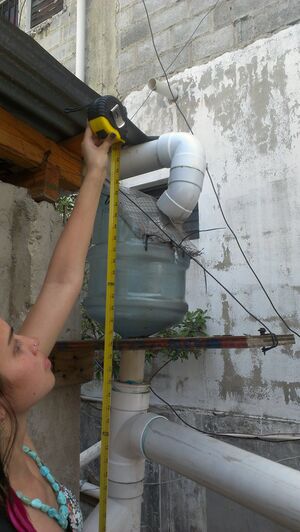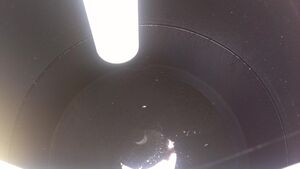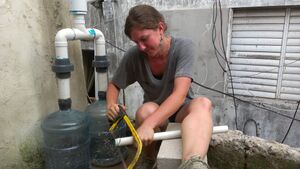
The Cal Poly Humboldt Dominicana Program, for the summer of 2012, has partnered with Universidad Iberoamericana (UNIBE), RevArk, and community members of La Yuca to improve the rainwater catchment system that was built during the 2011 Humboldt State Dominicana Program. The program takes place in Santo Domingo, Dominican Republic. The rainwater catchment system of 2011 is frequently used in La Yuca to provide water for cleaning, but the system had problems producing drinkable water. A group of 6 people worked on improving the La Yuca rainwater catchment system from 2011. This group consisted of Katy Castillo, Cheyenne Celada, Rosa Anali Guzman Molina, Erinn Parrish, Jesse Shrader, and Estaban Wick. Our group's goal was to improve the quality of water filtration so that rainwater catchment may be used to supply potable water for the grammar school in La Yuca. An estimated RD $300 will be saved weekly by the upgraded system. The system was also simplified and made more accessible for maintenance purposes. The involvement of La Yuca community members and UNIBE students ensures that the system will be more efficient and that the system will be maintained well after the program's end.
Problem Definition[edit | edit source]
The objective of this project is to provide inexpensive potable water and water for cleaning to the local school in La Yuca, Santo Domingo by use of rainwater catchment. Replacing purchased water with captured water may allow funds to be allocated for other important services.
Criteria[edit | edit source]
Criteria is a compilation of goals that are necessary to reach a final design. These criteria are designed to ensure that the project meets what the community of La Yuca wants.
| Criteria | Weight | Constraints |
|---|---|---|
| Aesthetics | 3 | Must be acceptable to the client |
| Ease of maintenance | 8 | Maintenance must be simple, quick and understandable |
| Safety | 10 | Must be safe for children to play around. Water must be potable. |
| Reproducibility | 9 | Must be replicable in similar situations with minor modifications |
| Adaptability | 8 | Must be flexible to changes desired by the user |
| Reproduction cost | 9 | Must be less than $1000 US |
| R&D cost | 3 | Must be less than $1000 US |
| O&M cost | 10 | Must be less than purchasing the same amount of potable water |
| Educational Value | 9 | Can be used for lessons by teachers |
| Durability | 9 | Must withstand strong tropical storms |

Literature Review[edit | edit source]
The Roof[edit | edit source]
Roof size can greatly influence the amount of rainwater that can be collected. The use of a metal roof is better than a textured roof, because the smooth surface of a metal roof helps dust and debris to easily slide off of the roof. The ability of metal to conduct heat from the sun allows a metal roof to kill some bacteria and other pathogens on the roof.
It is important to note that certain metals used in roofs can leach toxic chemicals into water. Roofs built using bitumen should be avoided because bitumen is directly related to adverse health effects and can also leave behind undesirable flavors. Aluminum roofing materials should be avoided as well. The seepage of aluminum into water has been linked with the development of Alzheimer's disease. Aluminum is commonly used as a roofing material, and building rainwater catchment systems using aluminum is often questioned due to health risks. While zinc is known to leach toxins, the amount of zinc present in a galvanized steel roof in is not enough to pose a health threat.
The effects of rust can be limited with the right selection of roofing material. Reducing the amount of rust that can form on the catchment roof will improve the quality of the water and can reduce operation and maintenance costs. Metals that can rust fast may negatively impact a system and prolong the system's buyback time.[1]
The Gutter[edit | edit source]
The gutter is used to transport water from the catchment surface to the first flush. The efficiency with which the gutter collects runoff water from the roof is dependent on the placement of the gutter. If the slope of the gutter is too steep, some of the runoff water will flow over the gutter. If the slope of the gutter is leveled, not all of the runoff water will flow out of the gutter into primary screening. Water left to set in the gutter will form stagnate water that will pose a risk of producing Mosquito larva and algae growth. It is a useful precaution to place an end cap on the gutter so that rodents and other small animals are unable to enter the system.
Seamless aluminum gutters are sustainable for the system. However, these gutters are not cost efficient for the system; they usually require professional installation at expensive rates. Lead gutters are never good for rainwater harvesting. The acidic levels present in rain are strong enough to deteriorate lead gutters over time and cause seepage of lead into the system, contaminating the entire water supply.[1]
Primary Screening[edit | edit source]
To avoid lowering the quality of water in a system, primary screening is necessary. Primary screening is a screen that prevents large debris from entering the catchment system from the roof. The use of primary screening limits the probability of blockages forming, which would cause water to be harvested more slowly.[1]
First Flush[edit | edit source]
In between periods of rainfall contaminants such as debris, air pollutants, dust, animal fecal matter, and various other particles accumulate on the collection surface. During the first few minutes of rainfall, these items will be washed off of the collection surface and enter the system. Debris and pollutants entering the storage tank will significantly lower the quality of water and effect the process of making the water potable. A first flush is used to divert this contaminated water away from the storage tank. The La Yuca system reroutes the contaminated water in a length of pipe that is capped at the end. When the pipe is filled with water, a ball shuts off the top of the pipe so additional rainfall flows directly into the rainwater storage tank. There are varying opinions on the amount of volume of rainwater to divert for the first flush. Varying opinions occur because there are many variables to consider, such as the slope and smoothness of the collection surface, the intensity of the rain and how long it rains.[1]
In order to effectively wash a collection surface, a rain intensity of one-tenth of an inch of rain per hour is needed to wash a sloped roof. A flat or near-flat collection surface requires 0.18 inches of rain per hour for an effective washing of the surface. The recommended diversion of first flush ranges from one to two gallons of first-flush diversion for each 100 square feet of collection area.[1]
Storage Unit[edit | edit source]
Usable water flows over the first flush into the storage unit. A storage tank or cistern may be used as a storage unit. The storage unit is used to store water during periods of rainfall, so that water maybe accessed during times of little or no rainfall. Storage tanks are usually the most expensive part of the system. Therefore, calculating the correct size of the storage unit necessary for a system should be done precisely.
To determine the necessary size of a storage tank consider:
- Size of the collection area
- Number of users
- Rate at which water is consumed
- Periods in between rainfall
- Local rainfall and climate[2]
Granular Filtration[edit | edit source]
Turbidity at certain levels can interfere with subsequent disinfection processes.[3] In order to reduce turbidity in the collected water, a granular, slow-sand filter will be used. Typically the granular filtration media (e.g. anthracite, garnet, sand) is placed on top of support media and a water collection system (i.e. gravel).
Slow sand filters tend to not use the entire filter depth as much as other granular filter types, such as rapid sand or multimedia high-rate filters. Slow sand filters accumulate water constituents on the very top level of the filter, which is referred to as the schmutzdecke. The schmutzdecke is periodically removed since it causes large amounts of head loss.
Disinfection[edit | edit source]
Suspended particles are removed by the sediment filter. The sediment filter prevents small particles that pass through primary screening- such as sand, dust, air pollutant particles, and small pieces of metal- from entering the silver impregnated activated carbon filter.[4] Activated carbon has a very high surface area and is ideal for constituent removal by adsorption. Activated carbon is known to remove taste and odor-causing compounds effectively as well as some trace organics.[5]
Chlorination[edit | edit source]
The process of adding chlorine oxidizes the cell membranes of microbes destroying the possibility of contamination. When adding chlorine, 2 fluid ounces (1/4 cup) must be added per 1,000 gallons of rainwater.[1]
Alternative Disinfection Methods[edit | edit source]
Other types of disinfection methods that may be used to treat microbes and pathogens present in water are:
- Chlorination
- Monochloramine
- Chlorine Dioxide
- Iodine
- Ozone
- Ultraviolet Irradiation
- Slow Sand Filtration
- Ion Exchange
- Reverse Osmosis
- Distillation
- Microporous Basic Filtration[1]
Testing[edit | edit source]
Testing the quality of water that leaves the system should be conducted regularly. This may be done by placing water samples in sterilized plastic bags and taking them to a nearby water quality lab for testing. Testing water quality regularly will help determine when the system and storage tank will need to undergo disinfection.[6]

Climate in The Dominican Republic[edit | edit source]
Temperature[edit | edit source]
The northern areas of the Dominican Republic tend to see the greatest amount of rainfall, whereas the southern areas of the Dominican Republic tend to be very hot and dry.[7] The average high temperature per year is 86º Fahrenheit and the average low temperature per year is 70º Fahrenheit.[8]
Hurricanes[edit | edit source]
Hurricanes can destroy an unstable rainwater catchment system. Routes and patterns of the hurricanes are unpredictable, but the greatest danger comes in August and September, when hurricanes can last up to two weeks.[9]
Rainfall[edit | edit source]
The average annual rainfall for the Dominican Republic is 150cm[10]
"Las cifras indican que en 50 años la ponderación de la intensidad de lluvia máxima para el diseño de las obras hidráulicas en el país se ha incrementado en un 40%", expresan los técnicos."[11] {Rainfall intensity has increased by 40% within the last 50 years.}
Calculations[edit | edit source]
- V: Volume of calculation
- R: Precipitation
- A: Foot Print of Collection Surface
- k: Conversion from to gal
- e: Efficiency of collection surface [12]
- The volume of calculation (V) is used to determine to the size of the storage tank needed
- Precipitation (R) is used to account for the amount of precipitation that occurs in a given amount of time
- The foot print of collection surface (A) is used to determine the area of the collection surface. The area can be found using the equation A= Length x Width
- Efficiency of the collection surface (e) is dependent on the material used for the area of catchment
- Conversion from ft3 to gal (k) used to convert units.
Design[edit | edit source]
The rainwater catchment system in La Yuca is composed of 6 main parts; the area of catchment, the gutter, primary screening, first flush, the storage unit, and the filtration.
-
Before:Sketch:The first flush
-
Before:Sketch:The primary screening, the first flush, and the storage
-
Before:Sketch:Primary Screening
| Area of Catchment
The La Yuca rainwater catchment system uses the galvanized steel roof of La Yuca ecoladrillo schoolroom as its catchement area. The system catchment area is approximately 175 ft2 (16 m2). The use of a steel roof galvanized in zinc reduces the amount of rust that will form on the area of catchment and enter the system. |
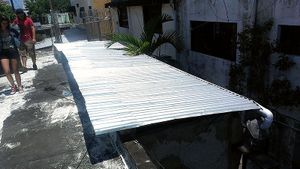 |
| The Gutter
A 3" PVC pipe is used for the gutter. The PVC pipe is cut down the middle and then attached to the area of catchment using wire to keep the gutter in place. At the end of the gutter is a 90º PVC pipe, to ensure that the runoff water flows directly into the primary screening and then enters the first flush. |
 |
| Primary Screening
To construct the primary screening a 5 gallon jug, commonly known as a botellon, is used. The botellon is glued upside down to a PVC pipe feeding into the first flush. The bottom of the botellon is cut at an angle. Attached to the bottom of the botellon is chicken wire and a tight knit screen. On the inside of the botellon is a stainless steel drain filter to help catch objects and prevent them from entering into the first flush, in case the first two screens get damaged. |
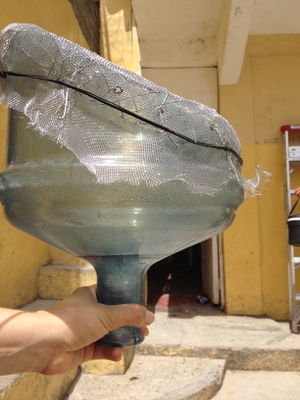 |
| First Flush
The first flush is constructed of a 3" PVC pipe that feeds into a T-section. When the first flush fills with contaminated water, a ball valve in the 3" PVC pipe shuts off access to the first flush and lets water flow into the storage tank. Two 5 gallon botellones are connected to the bottom of the first flush PVC pipe. In the bottom of the botellones are small holes that allow contaminated water to leave the system slowly. Above the botellones are connectors that attach to the pvc pipes. If it is necessary to check for problems, these connectors make it simple to take the first flush apart without causing damage to the rest of the system. The botellones used in the bottom of the first flush are painted to reduce exposure to sunlight, which causes algae growth. |
 |
| Storage Unit
A tinaco is used for the storage unit of the system. Tinacos are commonly used throughout the Dominican Republic to provide municipal water during power shortages. Tinaco's are located on the rooftops of houses to provided water pressure when needed for sinks, faucets, and toilets. The tinaco is raised onto cinder blocks to provide more head for the system. To ensure that the tinaco is secure, wire is used to tie it to the cinder blocks and bags of sand are used to weigh down the storage unit. |
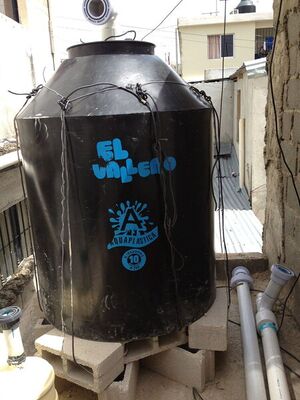 |
| Overflow
An overflow is provided on the side of the tinaco. To prevent larva and other small insects from entering the storage unit, a pipe with a small knit screen is attached to the overflow. This method will prevent mosquitoes from laying eggs on the side of the overflow that may eventually fall into the storage tank when the water level in the tinaco is low. |
 |
| Liter of Light
An 8" by 9.5" sheet of scrap metal was cut and glued with silicon to the galvanized aluminum roof to seal and prevent water from leaking through to the filtration. |
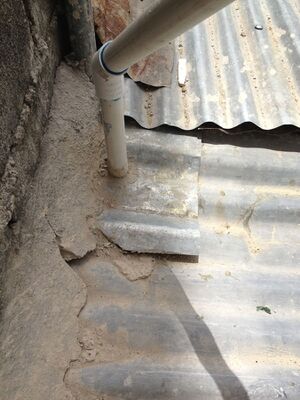 |
| Filtration
A sediment filter is used to filter out any remaining particles that may be left in the runoff water coming from the storage unit. A silver impregnated carbon filter is used to kill pathogens and bacteria present in the water. |
 |
Calculations[edit | edit source]
The equation is used to determine the size of tank necessary for the storage unit.
Cost[edit | edit source]
| Material | Quantity | Unit Cost (DOP) | Total Cost (DOP) |
|---|---|---|---|
| PVC 3" (29ft) | 1 | 1600 | 1600 |
| PVC 1" (5ft) | 1 | 70 | 70 |
| PVC 1/2" (5ft) | 1 | 50 | 50 |
| 5 Gallon Jug | 3 | 250 | 750 |
| 90 Degree- 3" PVC | 1 | 150 | 150 |
| 90 Degree- 1/2" PVC | 3 | 5 | 15 |
| T Branch- 3" PVC | 1 | 125 | 125 |
| T Branch- 1" PVC | 1 | 15 | 15 |
| 90 Degree- 1" PVC | 5 | 12 | 60 |
| 45 Degree- 1" PVC | 2 | 11 | 22 |
| Junta- 1/2" PVC | 1 | 22 | 22 |
| Junta- 1" PVC | 1 | 51 | 102 |
| Junta- 2' PVC | 2 | 227 | 454 |
| Junta- 3' PVC | 2 | 290 | 580 |
| Connectors PVC | 6 | 20 | 120 |
| Epoxy/Silicon | 2 | 150 | 300 |
| Cinder Blocks | 20 | 20 | |
| Shut off valves | 2 | 350 | 700 |
| Activated Carbon bucket Filter | 1 | 1600 | 1600 |
| Ball valve | 1 | donated | |
| Spigot | 2 | 235 | 470 |
| Tinaco | 1 | 3800 | 3800 |
| Total Cost | $11005 |
Buy Back[edit | edit source]
The buy back time was calculated using two different prices for drinking water bottles (Botellons).
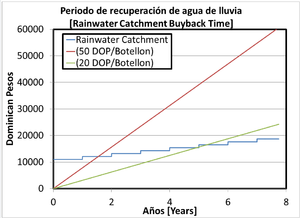
Discussion[edit | edit source]
Project Timeline[edit | edit source]
June 9, 2012[edit | edit source]
- Started Project
- Measured all pipe lengths, diameters, and calculate the volumes of the first flush and container.
- Tested flow rate of the filtered water out of the slow sand filter.
June 10, 2012[edit | edit source]
- Set Criteria.
June 11, 2012[edit | edit source]
- Formulated plans.
- Generated alternative designs.
June 13, 2012[edit | edit source]
- Discussed plans with a community member (Osvaldo)
- Looked at gutter systems nearby especially ones with sediment traps.
June 16, 2012[edit | edit source]
- Experimented with first flush containers that could be the correct size.
June 18, 2012[edit | edit source]
- Search for student participation in water testing.
June 19, 2012[edit | edit source]
- Plan filter installation.
June 21, 2012[edit | edit source]
- Raise rainwater storage for additional pressure head across the filters.
- Create a mosquito/insect barrier for the rainwater storage overflow using a diagonally cut PVC pipe and plastic screening material.
June 25, 2012[edit | edit source]
- Attached the sediment filter to concrete wall after drilling and properly installing the filter mount.
June 26, 2012[edit | edit source]
- Sourced Liter of Light materials.
- Built an alternative primary screen design.
- Connected the sediment filter to the rainwater storage container.
June 29, 2012[edit | edit source]
- Received a signed letter from UNIBE requesting free water quality testing.
July 7, 2012[edit | edit source]
- Secured the rainwater storage container to its cinder block foundation.
- Completed construction phase of the rainwater catchment.
- Began water quality testing phase.
How to build your own[edit | edit source]
Next Steps[edit | edit source]
Testing[edit | edit source]
Water testing is needed to ensure potability. Tests for the following will be performed:
- Biochemical Oxygen Demand (BOD)
- Total Suspended Solids (TSS)
- E. Coli
- Fecal Coliform
- Total Coliform
Video[edit | edit source]
Supporting Files[edit | edit source]
References[edit | edit source]
- ↑ 1.0 1.1 1.2 1.3 1.4 1.5 1.6 http://web.archive.org/web/20151105183703/http://www.twdb.state.tx.us/publications/reports/RainwaterHarvestingManual_3rdedition.pdf
- ↑ http://web.archive.org/web/20131212075953/http://practicalaction.org/docs/technical_information_service/rainwater_harvesting.pdf
- ↑ Davis, M. (2010). Water and wastewater engineering: design principles and practice.
- ↑ http://www.ianrpubs.unl.edu/live/g1492/build/g1492.pdf
- ↑ Ireland EPA WATER TREATMENT MANUALS FILTRATION
- ↑ http://www.pacificwater.org/userfiles/file/MR0579.pdf
- ↑ http://dominican.peacecorps.gov/pcdr.php
- ↑ http://web.archive.org/web/20140322170423/http://dominicanrepublic-guide.info/weather/
- ↑ http://www.peacecorps.gov/wws/publications/insights/.../InsightsBackground.pdf
- ↑ http://web.archive.org/web/20160324233358/http://www.nrel.gov/wind/pdfs/27602.pdf
- ↑ http://www.hoy.com.do/el-pais/2010/1/24/311243/print
- ↑ http://raintankdepot.com/pdf/rainwater-catchment-standards.pdf
- ↑ http://www.ldsglo.com/forum/showthread.php?t=12123












